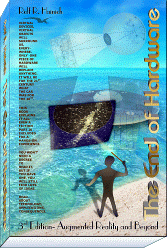Augmented Reality is more than Virtual Reality
Errata
Most of the display technology related theory in The End of Hardware also got included in the Near-Eye-Displays, Holographic Principles and Three-Dimensional Displays chapters in the new book Displays - Fundamentals and Outlook, which is a classical academic textbook and has been reviewed by a number of experts in the various disciplines.
Page 377 (Appendix)
Hong Hua discovered that the w(z) formula got out of order in this figure (this particular formula is not used in the book context, so this remains a singular error).
Pages 25 and 28: while preparing his foreword to our new DISPLAYS book, Henry Fuchs also read The End of Hardware and spotted a few inaccuracies in statements about computer history. I simply cite his words to amend this:
"The initial Xerox system that pioneered this kind of interaction" (i.e., the Windows approach) "was the Alto (1973), the earliest predecessor to the Star. The 'Star', a commercial machine, followed many years later (1981). The mouse was NOT part of this development. The Xerox PARC Alto developers adopted the mouse; it was developed by Doug Englebart in the late 1960's, famously demoed in 1968.
Sutherland developed his 1968 head-mounted display system at Harvard University and brought the system with him to Utah shortly thereafter. He didn't join Sun until many years later."home news
Copyright © 2006-2011 Rolf R. Hainich; all materials on this website are copyrighted.
Disclaimer: All proprietary names and product names mentioned are trademarks or registered trademarks of their respective owners. We do not imply that any of the technologies or ideas described or mentioned herein are free of patent or other rights of ourselves or others. We do also not take any responsibility or guarantee for the correctness or legal status of any information in this book or this website or any documents or links mentioned herein and do not encourage or recommend any use of it. You may use the information presented herein at your own risk and responsibility only. To the best of our knowledge and belief no trademark or copyright infringement exists in these materials. In the fiction part of the book, the sketches, and anything printed in special typefaces, names, companies, cities, and countries are used fictitiously for the purpose of illustrating examples, and any resemblance to actual persons, living or dead, organizations, business establishments, events, or locales is entirely coincidental. If you have any questions or objections, please contact us immediately. "We" in all above terms comprises the publisher as well as the author. If you intend to use any of the ideas mentioned in the book or this website, please do your own research and patent research and contact the author.

